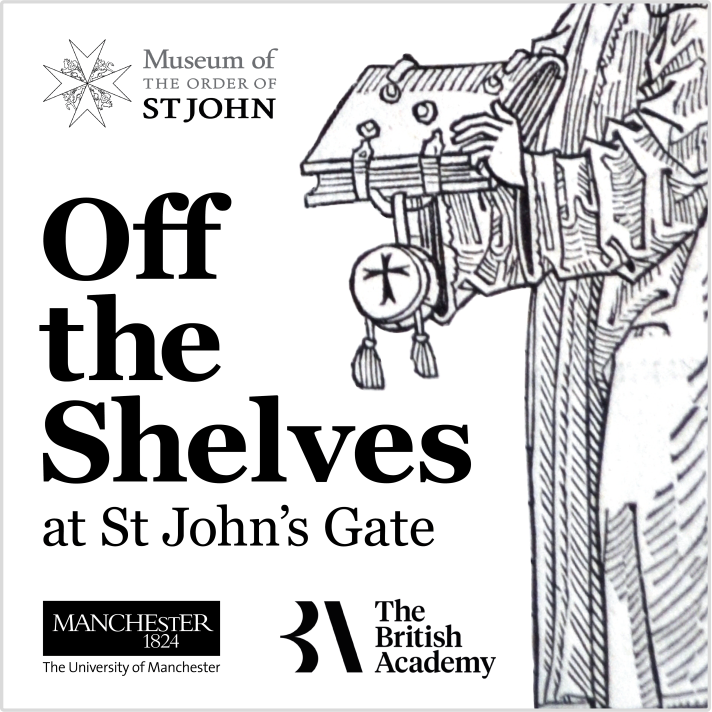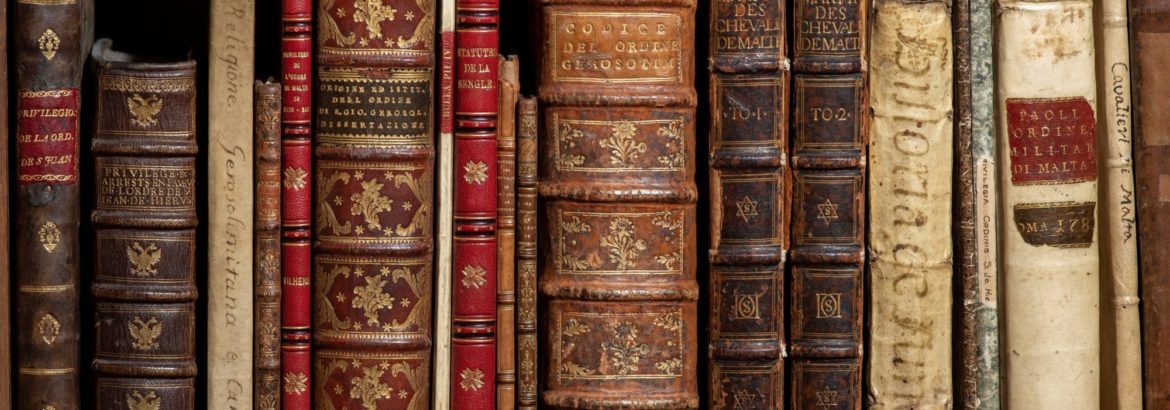The Library of the Museum holds historical and reference collections specialising in the history of the Knights Hospitaller, the Most Venerable Order of the Hospital of St John of Jerusalem and the international first aid charity St John Ambulance. Explore the collections on our online catalogue.
The Library Collections
The Library has always been a central component of the Order of St John, at least since 1838 when its very first books, which can also be considered the first items of the Museum’s collections, were housed in a locked box at the house of the Secretary. Today, the Library holds an extensive collection of historical and modern resources which provide scholars, students and enthusiasts with invaluable materials to explore and research the captivating history of the Order.

Central to the Library’s collections is the history of the Knights Hospitaller, spanning from their inception in the Holy Land to their sovereignty in Rhodes and Malta; but the library also covers various related subjects such as the Crusades, the Knights Templar and the history of the Latin East. Alongside this historical focus, the library’s collection also document the more recent history of the British Most Venerable Order of the Hospital of St John of Jerusalem – including its charitable foundations St John Ambulance and St John Ophthalmic Hospital –, as well as of the broader context of other military religious orders.

The collections encompass a wide range of materials, from beautifully illuminated manuscripts, such as the famous Rhodes Missal, to early printed books and ephemera, but also modern monographs, journals, and other reference materials. These resources are divided between the Mellows Library (Historic Library), dedicated to preserving the historical collections and rare items, and the Reference Library, which houses modern resources for the study of the history of the Order and related themes.
If you’d like to know more about our collections have a look at some of the highlights of our online collection or consult our online catalogue. To arrange a visit please get in touch at museum@sja.org.uk.
The Mellows Library (Historic Library)
Located in the west tower of St John’s Gate, the Mellows library houses our historical and rare collections. This remarkable repository boasts approximately 1.500 early printed materials, consisting of incunables, rare books, pamphlets, rolls and ephemera, alongside over 100 manuscripts. This little known, but internationally significant and fascinating collection was gathered over the years through the generous donations of the members of the Order as well as discerning acquisitions by previous librarians.

While remarkable as rare and indeed often unique historical objects, these holdings also provide invaluable insights into the history of Knights Hospitallers, the Crusades and the modern Venerable Order. Within these volumes lie numerous historical accounts on the Order’s Mediterranean sovereignty, literary works by or about the knights hospitallers, early statutes and privileges, proofs of nobility of joining members, as well as a wealth of documents on the British Order, such as rolls, minutes, heraldic works, family histories and much more.
Thanks to a donation from a generous Museum supporter, this collection is undergoing a comprehensive cataloguing project. All the records are accessible on our online catalogue and our dedicated Project Librarian is continuously enhancing them with additional bibliographic and historical information. This endeavour will greatly improve the access to our collections and promote their historical and cultural significance.
The Reference Library
The Reference library of the Museum houses the modern holdings within our library collections. With approximately 8.000 items, these resources serve as an invaluable reference tool for scholars, researchers, and Museum staff, covering the subjects related to the Museum collections. Among these holdings are specialized materials in various European languages, which are nowhere else to be found in the UK.

In addition to supporting the subject areas of the historical collections, the reference resources represent the primary destination for anyone interested in the modern Order of St John and its charitable foundations St John Ambulance and St John Ophthalmic Hospital. Another focus of this collection is the history of St John’s Gate and the myriad activities it hosted throughout its post-Reformation history: one example being an almost complete collection of The Gentleman’s Magazine, famously printed at the Gate during its peak years.
While only part of the resources from the Reference Library are currently available on our catalogue, efforts are underway to produce online records. The Project Librarian is currently overseeing a team of trained volunteers to make the records available online and is devising a classification scheme aimed at making the collection easily browsable for visitors and the Museum staff.
Our projects
We always strive to enhance our library collections, making them more accessible to both researchers and the general public and unlocking the fascinating stories and treasures resting on the shelves.
One of our most recent projects is the digitisation of part of the Mellows Library’s historical collections, through a collaboration with the Malta Study Center at the Hill Museum & Manuscript Library (HMML). Once completed, hundreds of items from the Library will be fully available online on the HMML Reading Room, fully catalogued and browsable. This will provide an invaluable source of research for scholars and students, while also offering the public an opportunity to easily explore our wonderful collections. Have a look at our dedicated blogpost to find out more about it.

To further promote our collections, we’ve also launched a new captivating podcast series, Off the Shelves at St John’s Gate, in collaboration with the University of Manchester and the British Academy. Hosted by Dr Stephen Mossman, this series will offer enlightening conversations on the Medieval and Early Modern history of the Order of St John drawing from our library collections. What is more, in the last episode of the series, we will answer all the questions and curiosities from our listeners: do please write to us at museum@sja.org.uk and we’ll do our best to answer!

Another library project we take great proud in is the research on the history of the Library we are conducting with our volunteers. Prompted by the recent rediscovery of our 1876 library catalogue, we have involved our dedicated volunteers in studying the library’s past reports and many other Museum’s sources on the history of the library collections.

At the end of the project, we will be able to paint a clearer picture of the Library’s history, from its inception in 1838 as a few books in a locked box, to the appointment of the first librarian in 1867 and the first introduction of a card catalogue in 1901. This project will also shed light on the Library’s role in the foundation of the Museum and provide crucial information on the provenance of numerous items within our collections.
For updates on our projects and more, please visit our Research – Projects Blog as well as our general Museum Blog.


